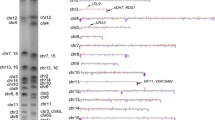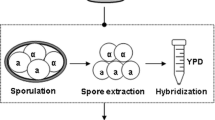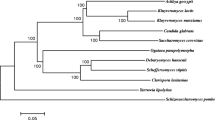Abstract
Saccharomyces cerevisiae has been known for its applications in a wide range of industries such as food and beverages, pharmaceuticals, bioethanol and feed industries. Mitr Phol Innovation and Research Center has successfully isolated and developed a few Saccharomyces cerevisiae strains for their ethanol plants located in four different regions of Thailand. Industrial ethanol production in Thailand is typically conducted without a strictly aseptic bioreactor using molasses as the feedstock. In order to increase ethanol production and its efficiency, the yeast strains require the ability to tolerate ethanol concentrations higher than 10% (ethanol v/v) and stresses from molasses. Since the conventional method to isolate yeast strains from natural resources is laborious, random and costly, it is necessary to use an alternative method using bioinformatics and systems biology for better understanding of the genetic–phenotypic relationship that helps to discover target genes for yeast improvement. It was found that our isolated strains (MP11, MP15) show high ethanol production compared with the commercial strain Angel Super Alcohol (Angel Yeast, Co. Ltd.). Therefore, we selected 10 important genes (ADH1, ADH3, ADH4, ADH5, HXT1, HXT2, HXT3, HXT4, TPI1 and SUC2) based on previous publications to clone and sequence candidate genes of Mitr Phol’s yeast strains. After that, we applied comparative sequence analysis among yeast strains to identify DNA variation in genes that are relevant to ethanol production. From the results, the most variation of DNA sequence was found in a primary enzyme for ethanol production (ADH1) of about 12%. In addition, the variation of ADH1 was also found at substrate binding sites among our isolated and commercial strains. This result implies that genetic variation among yeast strains has an effect on ethanol production especially on the key enzyme in the ethanol pathway. In order to implement yeast strains with the specific trait to improve ethanol production, genetic information of each yeast strain is required to further apply this strategy for stress tolerance traits.





Similar content being viewed by others
References
Bankevich, Anton, Sergey Nurk, Dmitry Antipov, Alexey A. Gurevich, Mikhail Dvorkin, Alexander S. Kulikov, Valery M. Lesin, et al. 2012. SPAdes: A new genome assembly algorithm and its applications to single-cell sequencing. Journal of Computational Biology 19: 455–477.
Basso, Luiz C., Henrique V. de Amorim, Antonio J. de Oliveira, and Mario L. Lopes. 2008. Yeast selection for fuel ethanol production in Brazil. FEMS Yeast Research 8: 1155–1163.
Berman, H.M., J. Westbrook, Z. Feng, G. Gilliland, T.N. Bhat, H. Weissig, I.N. Shindyalov, and P.E. Bourne. 2000. The Protein Data Bank. Nucleic Acids Research 28: 235–242.
Berthels, N.J., R.R. Cordero Otero, F.F. Bauer, J.M. Thevelein, and I.S. Pretorius. 2004. Discrepancy in glucose and fructose utilisation during fermentation by Saccharomyces cerevisiae wine yeast strains. FEMS Yeast Research 4: 683–689.
Berthels, Nele J., Ricardo R. Cordero Otero, Florian F. Bauer, Isak S. Pretorius, and Johan M. Thevelein. 2008. Correlation between glucose/fructose discrepancy and hexokinase kinetic properties in different Saccharomyces cerevisiae wine yeast strains. Applied Microbiology and Biotechnology 77: 1083–1091.
Bethesda (MD). 1988. National Center for Biotechnology Information (NCBI). https://www.ncbi.nlm.nih.gov/. Accessed 11 May 2017.
Compagno, C., F. Boschi, and B.M. Ranzi. 1996. Glycerol production in a triose phosphate isomerase deficient mutant of Saccharomyces cerevisiae. Biotechnology Progress 12: 591–595.
Engel, Stacia R., and J.Michael Cherry. 2013. The new modern era of yeast genomics: Community sequencing and the resulting annotation of multiple Saccharomyces cerevisiae strains at the Saccharomyces Genome Database. Database (Oxford) 2013: bat012. https://doi.org/10.1093/database/bat012.
Guillaume, Carole, Pierre Delobel, Jean-Marie Sablayrolles, and Bruno Blondin. 2007. Molecular basis of fructose utilization by the wine yeast Saccharomyces cerevisiae: A mutated HXT3 allele enhances fructose fermentation. Applied and Environmental Microbiology 73: 2432–2439.
Jiménez-Martí, E., A. Zuzuarregui, M. Gomar-Alba, D. Gutiérrez, C. Gil, and M. del Olmo. 2011. Molecular response of Saccharomyces cerevisiae wine and laboratory strains to high sugar stress conditions. International Journal of Food Microbiology 145: 211–220.
Kutyna, Dariusz R., Cristian Varela, Paul A. Henschke, Paul J. Chambers, and Grant A. Stanley. 2010. Microbiological approaches to lowering ethanol concentration in wine. Trends in Food Science & Technology 21: 293–302.
Lewis, Jeffrey A., Isaac M. Elkon, Mick A. McGee, Alan J. Higbee, and Audrey P. Gasch. 2010. Exploiting natural variation in Saccharomyces cerevisiae to identify genes for increased ethanol resistance. Genetics 186: 1197–1205.
Liti, Gianni, David M. Carter, Alan M. Moses, Jonas Warringer, Leopold Parts, Stephen A. James, Robert P. Davey, et al. 2009. Population genomics of domestic and wild yeasts. Nature 458: 337–341.
Mohd Azhar, Siti Hajar, Rahmath Abdulla, Siti Azmah Jambo, Hartinie Marbawi, Jualang Azlan Gansau, Ainol Azifa Mohd Faik, and Kenneth Francis Rodrigues. 2017. Yeasts in sustainable bioethanol production: A review. Biochemistry and Biophysics Reports 10: 52–61.
Piskur, Jure, and Rikke B. Langkjaer. 2004. Yeast genome sequencing: The power of comparative genomics. Molecular Microbiology 53: 381–389.
Raj, Savarimuthu Baskar, S. Ramaswamy, and Bryce V. Plapp. 2014. Yeast alcohol dehydrogenase structure and catalysis. Biochemistry 53: 5791–5803.
Saitou, N., and M. Nei. 1987. The neighbor-joining method: A new method for reconstructing phylogenetic trees. Molecular Biology and Evolution 4: 406–425.
Schrödinger, LLC. 2015. The PyMOL Molecular Graphics System, Version 1.8 (Computer Software).
de Smidt, Olga, James C. du Preez, and Jacobus Albertyn. 2012. Molecular and physiological aspects of alcohol dehydrogenases in the ethanol metabolism of Saccharomyces cerevisiae. FEMS Yeast Research 12: 33–47.
Tesfaw, A., and F. Assefa. 2014. Current trends in bioethanol production by Saccharomyces cerevisiae: Substrate, inhibitor reduction, growth variables, coculture, and imobilization. International Scholarly Research Notices 2014: 1–11. https://doi.org/10.1155/2014/532852.
Vaudano, Enrico, Antonella Costantini, Olta Noti, and Emilia Garcia-Moruno. 2010. An RT-qPCR approach to study the expression of genes responsible for sugar assimilation during rehydration of active dry yeast. Food Microbiology 27: 802–808.
Warringer, Jonas, Enikö Zörgö, Francisco A. Cubillos, Amin Zia, Arne Gjuvsland, Jared T. Simpson, Annabelle Forsmark, et al. 2011. Trait variation in yeast is defined by population history. PLoS Genetics 7(e1002111): 1–15. https://doi.org/10.1371/journal.pgen.1002111.
Waterhouse, Andrew, Martino Bertoni, Stefan Bienert, Gabriel Studer, Gerardo Tauriello, Rafal Gumienny, Florian T. Heer, et al. 2018. SWISS-MODEL: Homology modelling of protein structures and complexes. Nucleic Acids Research 46: W296–W303.
Zabed, Hossain, Golam Faruq, Jaya Narayan Sahu, Mohd Sofian Azirun, Rosli Hashim, and Amru Nasrulhaq Boyce. 2014. Bioethanol production from fermentable sugar juice. The Scientific World Journal 2014: Article ID 957102.1-11. https://doi.org/10.1155/2014/957102.
Acknowledgements
The authors gratefully acknowledge financial support from Mitr Phol Biofuel Co., Ltd.
Author information
Authors and Affiliations
Contributions
SC performed analysis on all samples, interpreted data and wrote manuscript. NW and SP helped to design and conduct experiments. KS and MS helped to evaluate and edit the manuscript. All authors read and approved the final manuscript.
Corresponding author
Ethics declarations
Conflict of interest
The authors declare that they have no conflict of interest.
Additional information
Publisher's Note
Springer Nature remains neutral with regard to jurisdictional claims in published maps and institutional affiliations.
Rights and permissions
About this article
Cite this article
Chatsurachai, S., Watanarojanaporn, N., Phaengthai, S. et al. Genetic Variation in Genes Involved in Ethanol Production Among Saccharomyces cerevisiae Strains. Sugar Tech 22, 250–258 (2020). https://doi.org/10.1007/s12355-019-00771-4
Received:
Accepted:
Published:
Issue Date:
DOI: https://doi.org/10.1007/s12355-019-00771-4




